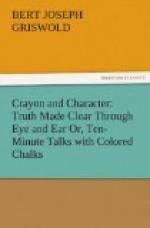THE FOURTH STEP—All of the preparations up to this time have been done in the quietude of your own room. You are now ready to place your drawing board before your audience. After a smile of greeting you begin your talk. “Let us,” you say, “talk for a little while about our thoughts,” and then you proceed until you reach the reference to the sour-faced man. “Here, for instance,” you continue, “is a man with a face something like this:” and you begin your drawing, starting anywhere you choose. Take your time, and when you have finished the sour face, the audience will show its appreciation with a heartily responsive smile. This completes Fig. 7. Proceed then with the talk until you reach the reference to the man with the sunny face. “Here comes a man who looks something like this:” Draw the second face, and you will have completed Fig. 8 and reached the climax of the drawing. As you make the application of the lesson, you will feel that your effort has already repaid you for the work you have undertaken, and each succeeding attempt will make the work easier until it becomes a pleasing habit.
[Illustration: Fig. 5]
In Fig. 5 and Fig. 6 are shown a section of each of the faces of the talk just referred to. Here they are enlarged four times. A-A shows the preliminary pencil lines forming the one-inch squares, B-B indicates the pencil outlines of the faces, and C-C illustrates the tracing of the pencil lines with the chalk. In this instance black chalk only is required.
[Illustration: Fig. 6]
Outlining the Right Picture.
In some of the talks in the book, the dotted squares cover the upper picture; in others, they are drawn over the lower picture. In either case, the one containing the squares is the one to be outlined on your drawing paper.
Not an Artist, But a Teacher.
There should be no hesitation on your part to trace with chalk the pencil lines which you have placed on your drawing paper. Remember, always, that you are posing as a humble teacher of God’s Word and not as an artist. Your pencil outline holds the same relation to your chalk talk that the minister’s notes hold to his sermon. Both are prepared in advance to enable the speaker to best present his message. Do not try to conceal your method. There is nothing about it of which you need be ashamed.
Finishing Part of the Drawing in Advance.
Now that the process has been explained in detail, a thorough understanding of the suggestion under the heading, “Important to Beginners,” seems most essential as a still easier way to do the work. Finishing part of the work in advance still leaves the speaker something to do, and the audience will always be interested in finding out what that “something” is to be.
The Value of Individuality.




